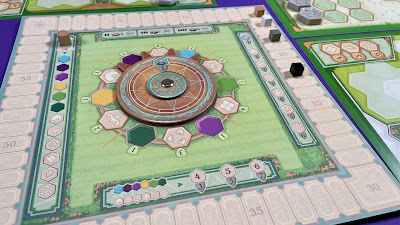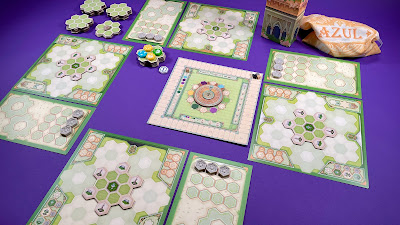AZUL: QUEEN'S GARDEN
a review of the board game Designed by Michael Kiesling
Players: 2-4 Time Investment: 60 min
Rating:
 |
| Weeping |
Game Aesthetic
Components
Strangely the component quality was all over the place in this game. The player boards and score board were made of a flimsy cardboard that was nothing like the original Azul game. On the other hand, the tiles were made of the familiar resin material that made you want to eat the pieces. The gray Joker pieces were of a cheaper material that made a high pitched noise when they clacked together in the insert. The thickest piece in the game was the rotating scoring indicator which I found an odd choice since you only interact with it at the beginning of the round.
Artwork by Chris Quilliams
The most attractive parts of the game were the tower art and the board game box. Everything else was as one would expect and nothing of note. They did really nail down the garden aesthetic with the pastel green palette, and that contrasted against the more vibrant colors of the tiles created a pleasing experience during gameplay. I do wonder whether you would actually be buying bugs or birds in a garden but I'll just leave that one alone.
The First Turn
Options
It's relatively straightforward to figure out what you need to do on your turn as you have four actions to choose from: acquire tiles and garden expansions, place a tile, place a garden expansion, or pass. While this may seem easy, in practice there is a lot more going on in each of these actions (except for passing, of course). You can only acquire tiles that have one thing in common but the rest of their features need to be different. Placing a tile requires that you have other tiles and/or expansions that follow this same logic, with the exception of using Jokers to do this.
Rewards and Objectives
There are clear in-game point scoring options, end-game point scoring options and Joker resources to obtain depending on whether you can surround a fountain, statue, bench or pavilion. All of these rewards can help inform where you place tiles or expansions, as they will score based on color or pattern. The real challenge is in attempting to create several groups that can score multiple times throughout the game and at the end of the game.
Ability to Pivot
Unfortunately it will become difficult to navigate around incorrect tile or expansion placements and because of the strict nature of the game's puzzle it can force you to start over in a way. There may be times where the tiles drawn from the bag just aren't want you need and you need to change up what your original plans are. Even your opponents' choices can force you to pivot your approach and perhaps give up on scoring for specific groups. In fact, you may even get in your own way because all of the tiles and expansions in your storage are ones that you'd like to place in your garden. Yet gameplay mechanic restrictions prevent you from having them all.
 |
| At the center of the board is the in-game "end of round" scoring and at the side and bottom of the board is the end game scoring |
Game End
The game ends after all players have passed during the fourth round. Once the final in-game scoring opportunities are complete, the end game scoring starts with counting remaining Jokers, removing points for having remaining tiles or expansions, then evaluating all aspects of the garden like colors, patterns, and groups of 3 or more. For those with enough planning prowess, there are additional bonus points for each group of six, though the other side of the board has a variant for groups of four and five as well.



